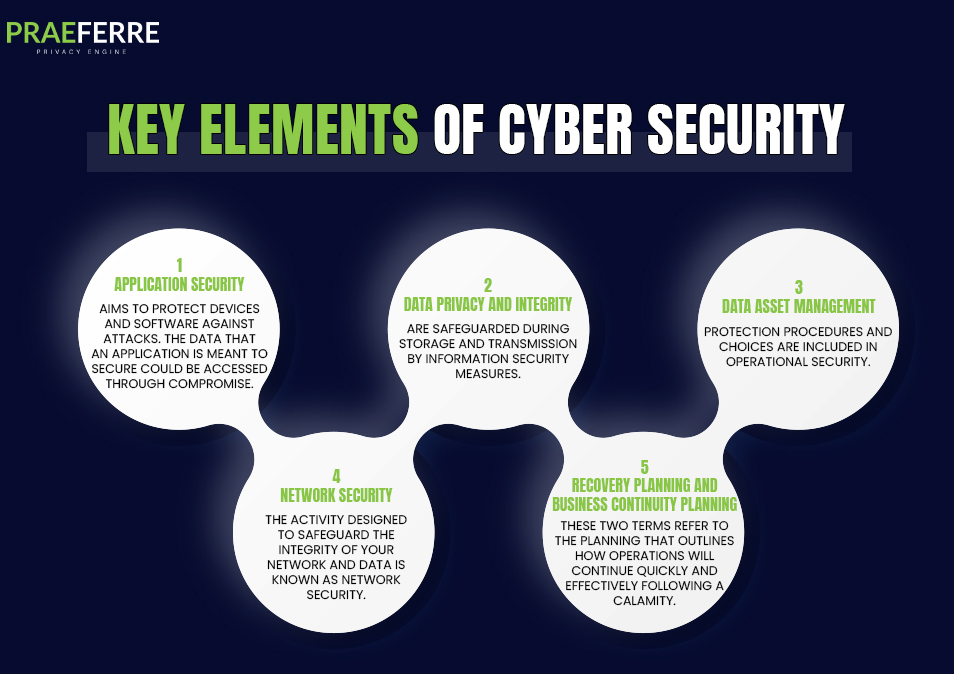What is Cyber Security?
This can be described as a process of protecting computers, servers, mobile devices, electronic systems, and data from malicious invasions and this process is known as cybersecurity or electric information security.
Key Elements of Cyber Security and how does it work?
Cybersecurity can be described as the process of safeguarding a computer network against trespassers, be they malevolent actors or malicious software, known as network security. And here are some important key elements of cyber security:

- Application security: Application security aims to protect devices and software against attacks. The data of an application is meant to be secure and could be accessed through compromise. Effective security starts long before a program or gadget is used, during the design phase.
- Data privacy and integrity: Data privacy and integrity are safeguarded during storage and transmission by information security measures.
- Data asset management: Data asset management, protection procedures, and choices are included in operational security. This includes the rights that users have while logging onto a network and the policies that dictate where and how data can be shared or stored.
- Network Security: Network Security designed to safeguard the integrity of your network and data. Every business or organisation that deals with a lot of data has some sort of defense against various online dangers. Network security refers to any measures taken to protect the accuracy and value of your data and network. This is a broad, all-inclusive term that includes hardware and software solutions, as well as policies, processes, and configurations for network access, general threat protection, and network usage.
- Recovery Planning and Business Continuity Planning: These two terms refer to the planning that outlines how operations will continue quickly and effectively following a calamity. Starting at the business level, a disaster recovery strategy should identify which apps are typically essential to the day-to-day operations of the association. Preparedness for cyber threats is closely linked to business continuity planning (BCP), which identifies threats to the organisation ahead of time and looks at potential effects on operations and how to mitigate them.
Benefits of Cyber security:
As we discussed the issues related to cyber security and since we almost depend majorly on online data storage, arose the need to get the issues resolved. Hence are some various tools and techniques are curated to solve the issues. It also is a long, cost-saving technique.
To conclude it all, cyber security provides comfort in knowing that operations and digital assets are safe at all times.
Types of cyber threats:
Cyber threats change at a very rapid pace.
Cybercriminals these days can access any computer or network server to cause harm using several paths and ways. This is commonly known as an Attack Vector.
The common types of Cyber Threats are as follows:
- Malware: This is also known as malicious software. Malware is software that is inserted into a system that can harm and compromise the security, integrity, or even data. It has become one of the most external threats to the system. Malware designed to compromise privacy, known as spyware, has also grown to be a significant threat to businesses.
- Ransomware: Via malware, ransomware restricts or stops people from accessing the computers of the users. To recover access to your system or data, ransomware demands that you use online payment channels to pay a ransom amount to solve the problem. This issue has become a challenge for everyone.
- Distributed denial of service (DDoS) attacks: Such attacks make online services unavailable by overwhelming them with excessive traffic from various points or sources. It can lead to slower response time, leading to no access during the attack.
- Spam and Phishing: Spam includes unwanted or undesirable messages, emails, etc.
- Corporate Account Takeover (CATO): CATO is a type of cybercrime where thieves assume the identity of a business and send wire and ACH transactions without authorisation. The money that is not allowed is transferred to accounts under the cybercriminal’s control.
- Automated Teller Machine (ATM) Cash Out: ATM One kind of ATM fraud with a high dollar value is cash out.
Why are cyber security services important?

Cyber security tools:
While the increased challenges of security there are various tools that one can relay on for security. Some of the names are shared below
1. Wireshark: An open-source, free packet analyser is called Wireshark. It is employed in analysis, education, software and communications protocol creation, and network troubleshooting.
2. Snort: Developed in 1998, Snort is a free and open-source network intrusion detection and prevention system.
3. Nmap: It is a tool for scanning computer networks for hosts and services by sending packets and examining the replies.
4. Kali Linux: It is a Linux distribution intended for penetration testing and digital forensics.
5. Metasploit: It is a computer security system that provides information about security vulnerabilities and helps in penetrating testing.
Conclusion:
We got to know above what exactly is cyber security and why it is important these days. To brief it out, cyber security is: tools or strategies that are used to defend networks from harm or attack from any source is known as cyber security. Threat prevention, identification, and reaction are important components. Implementing comprehensive security measures requires the use of tools such as Firewall, Kali Linux, etc which are commonly used these days for protection. There are various tools that can be used for similar purposes.
